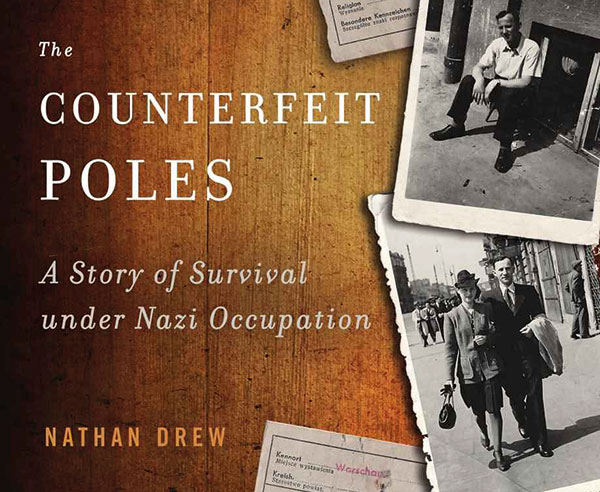
Jerry and Kathy Drew
In October 1942, when Nathan Drew and his wife Helen heard rumors that Nazis would liquidate the Łomźa Ghetto in Poland in which they lived, they escaped to Warsaw, avoiding by mere hours the forced removal of over 8,000 Jews to the Zambrow transit camp. In Warsaw, Nathan and Helen used false identification documents to live in the open as “counterfeit Poles,” hiding their Jewish heritage while navigating the harsh realities of Nazi occupation. They both worked for the resistance, creating and delivering fake documents for the People’s Army of Poland, though Helen was eventually sent to Neustadt labor camp during the 1944 liquidation of Warsaw. Through a remarkable display of wit, strength, and courage, Nathan and Helen survived the war and eventually made their way to the United States.
Wracked with survivor’s guilt at the fact that he and Helen lived while so many others did not, Nathan later dictated a memoir of his experiences. “He never considered himself a survivor, because he was not in a camp,” said Nathan’s son, Jerry, who lives outside Philadelphia and teaches economic history at the University of Pennsylvania. “He felt he did not suffer enough.” The memoirs sat in Jerry and his wife Kathy’s house for years, until Jayne Perilstein, a family friend and USC Shoah Foundation’s Managing Director of Advancement, encouraged the Drews to have them published.
The resulting book, The Counterfeit Poles, provides a detailed account of Nathan and Helen’s survival, as well as a record of the Jewish community in Łomźa and Warsaw. According to Jerry, Nathan was purposeful in his frequent naming of people and places: “By naming people, he was ensuring they would not be forgotten. By naming places, he was reclaiming the space itself for those who had been lost.” While attending a presentation by UPenn professor Mélanie Péron, who was awarded the Institute’s Rutman Fellowship for integrating VHA testimony into her coursework, the Drews were very impressed with the work of UPenn student Kyra Schulman, Professor Péron’s research assistant, and recruited her to aid in their project. With Kyra’s help, the Drews created a website (http://counterfeitpoles.com) to accompany the book. The result is a comprehensive collection of maps, photographs, and testimony sourced in part from the Visual History Archive, providing viewers with supplemental information that brings Nathan and Helen’s story to life in captivating detail.
Having firsthand experience of the power of testimony, for both the general public and for survivors themselves, the Drews were eager to help others share their survival stories. When the opportunity arose to support USC Shoah Foundation’s Last Chance Testimony Collection, a new initiative to document the remaining stories of over 300 witnesses and survivors while they are still able to share them, the Drews didn’t hesitate. Supporting the acquisition of new testimonies in the VHA would provide these survivors the same opportunity to tell their stories that Nathan had, ensuring that their testimonies, and the people and places within them, would live on.
To Jerry and Kathy, the education that can be gleaned from the VHA is imperative to ensure that the stories of the Holocaust do not fade from our collective memory. As Jerry said, “People have to know this history and not allow it to happen again.”